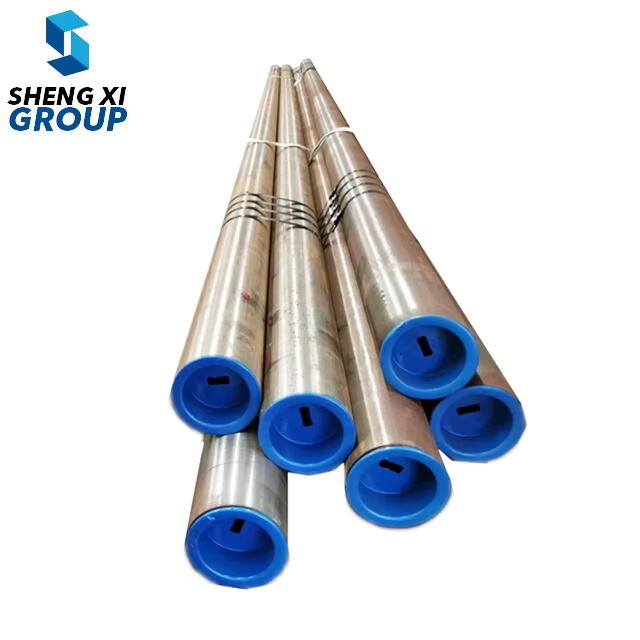الدور المتغير للفولاذ المقاوم في الصناعة الحديثة
القوى الدافعة وراء ابتكار الفولاذ المقاوم
ما الذي يدفع الابتكار في الفولاذ السبائكي؟ لا تبحث بعيدًا عن التحسينات المستمرة التي تحدث في التكنولوجيا وطرق التصنيع. تخصص شركات الفولاذ حاليًا ميزانيات كبيرة ل labs البحث والتطوير، في محاولة لابتكار سبائك تعمل بشكل أفضل وتتكيف بسرعة أكبر مع الاحتياجات المختلفة. وفي قلب كل هذا الابتكار تكمن حقيقة بسيطة: ترغب الصناعات في الحصول على مواد تؤدي مهامًا لا يستطيع الفولاذ العادي القيام بها. خذ على سبيل المثال مهندسي الطيران الذين يحتاجون إلى مكونات قوية ولكن خفيفة الوزن، أو المهندسين المعماريين الذين يصممون مباني يجب أن تتحمل الظروف الجوية القاسية دون إضافة وزن غير ضروري. تستمر الطلبات في الازدياد. وفي الوقت نفسه، تواصل أسعار المواد الارتفاع بينما تزداد المنافسة حدة. ليس أمام الشركات المصنعة خيار سوى تعديل تركيباتها مرارًا وتكرارًا. تدفع هذه المزيج من التحديات التقنية والحقائق الاقتصادية قدمًا في تطور الفولاذ السبائكي عبر قطاعات البناء والسيارات وعديد من المجالات الأخرى حيث تكون الأداء هي العامل الأهم.
تأثير الطلب العالمي على البنية التحتية والسيارات
إن تطوير البنية التحتية في الأسواق الناشئة يُسهم في زيادة الطلب على الفولاذ السبائكي عالي الجودة، خاصةً في مشاريع البناء وشبكات النقل. في الوقت نفسه، تغيّر شركات تصنيع السيارات منهجها مع التركيز على إنتاج مركبات أخف وزنًا وذات كفاءة أفضل في استهلاك الوقود لتلبية القواعد البيئية الأكثر صرامة من الحكومات حول العالم. وقد بدأت الشركات المصنعة باستخدام خلطات سبائك خاصة لمواكبة هذه المواصفات الجديدة. ومن المتوقع أن تبقى صناعة السيارات عاملاً رئيسياً في دعم استهلاك الفولاذ السبائكي على مدى السنوات العشر القادمة على الأقل. وتشير بعض التوقعات إلى نمو سنوي يقدر بحوالي 5 بالمئة فقط من السيارات التي تحتاج إلى مواد أقوى ولكنها أخف وزنًا. وهذا يعني عمليًا أن الفولاذ السبائكي سيظل مكونًا أساسيًا في مشاريع البناء ومصانع التجميع مع تكيّفها مع متطلبات العصر الحديث.
إنجازات في تركيبات السبائك المتقدمة
صيغ خفيفة الوزن عالية القوة
أصبح السعي وراء مواد أقوى مع خفة أكبر أمراً بالغ الأهمية في صناعات الطيران والسيارات. عندما تنجح الشركات في تقليل حتى كميات صغيرة من الوزن من منتجاتها منتجات ، فإنهم يرون مكاسب حقيقية في أداء تلك المركبات واستهلاكها للوقود. يعمل المهندسون حاليًا على مزيج مختلف من السبائك، بما في ذلك مزيج الألومنيوم مع الليثيوم، والذي يبدو أنه يوفر تقليلًا كبيرًا في الوزن دون التأثير على متطلبات القوة. وبحسب بيانات حديثة من القطاع، يمكن أن تقلل بعض هذه المزيجات الجديدة من كتلة المركبة الإجمالية بنسبة تصل إلى 10 بالمئة، مما ينعكس على شكل تحسين في كفاءة استهلاك الوقود وانخفاض في الانبعاثات. بالنسبة لمصنعي السيارات الذين يواجهون لوائح بيئية أكثر صرامة، وعملاء يريدون سيارات أسرع دون التفريط في السلامة، تمثل هذه التطورات تحولًا جذريًا. ومع تصاعد المنافسة في سوق السيارات، نحن نشهد اعتمادًا متزايدًا من قبل الشركات المصنعة لهذه السبائك المتقدمة كجزء من استراتيجياتهم للبقاء في المقدمة في ظل ما يبدو أنه تحول طويل الأمد نحو وسائل نقل أخف وأكثر كفاءة.
سبائك مقاومة للتآكل لمحيطات شديدة
في قطاعات مثل العمليات البحرية ومصانع المعالجة الكيميائية، لا يمكن تجنب سبائك مقاومة للتآكل عند التعامل مع ظروف بيئية قاسية تؤدي إلى تآكل المواد القياسية. لقد ساهمت التحسينات الأخيرة في خلطات المعادن التي تحتوي على النيكل والكروم بشكل كبير في تحسين حالة الأجزاء التي تتعرض يومياً لعناصر قاسية. إذا نظرنا حول أي موقع صناعي، سنلاحظ أن هذه السبائك الخاصة تساهم في إبقاء المعدات الأساسية قيد التشغيل لفترة أطول من ذي قبل، وتشير بعض الدراسات إلى أن العمر الافتراضي قد يزداد بنسبة 30 بالمئة، مما يعني تقليل الأعطال وخفض المصروفات على الإصلاحات. ولكن بعيداً عن توفير المال، فإن الأهم هو امتلاك أنظمة موثوقة، خاصة في الحالات التي قد تؤدي فيها الأخطاء إلى مشكلات جادة. مع تشغيل الشركات بشكل متزايد في مواقع أكثر قسوة، هناك اهتمام مستمر بحلول مواد مخصصة مثل هذه السبائك المتخصصة التي تتفوق في مقاومة التآكل مقارنة بأي خيارات أخرى متاحة.
درجات الصلب المعززة بالموليبدينوم
عند إضافة الموليبدنوم إلى سبائك الصلب، تصبح هذه السبائك أقوى بكثير وأطول عمرًا، مما يجعلها مناسبة جدًا للقطع التي تحتاج إلى تحمل إجهاد شديد. تُظهر الأبحاث أن الصلب الذي يحتوي على إضافات من الموليبدنوم يمكنه بالفعل تحمل درجات الحرارة والضغوط العالية التي قد تؤدي إلى انصهار الصلب العادي. تستفيد منصات الحفر النفطية وخطوط أنابيب الغاز بشكل كبير من هذه الخاصية، لأنها تعمل في ظل ظروف قاسية لا يمكن فيها التساهل مع فشل المعدات. تسمح هذه الأنواع المحسّنة من الصلب للشركات بالعمل في مواقع صعبة دون مواجهة أعطال متكررة أو مشكلات صيانة مستمرة. وجود الموليبدنوم في خلطات الصلب يعني الآن توفر مواد أفضل لمشاريع البناء في جميع أنحاء العالم، وقد بدأ العديد من المصنّعين بالاعتماد عليه بشكل كبير في أكثر تطبيقاتهم تحديًا.
التصنيع الأخضر وإقتصاد الدائرة
تقنيات الإنتاج المتعادلة كربونيًا
يأخذ صانعو الصلب على محمل الجد أمر خفض الانبعاثات الكربونية حيث يعملون نحو اعتماد أساليب إنتاج أكثر خضرة على نطاق واسع. لقد بدأت العديد من الشركات مؤخرًا ضخ الأموال في مبادرات الاستدامة، في محاولة لتقليص تأثيرها على الكوكب. بعض الاختراقات التكنولوجية الجديدة قللت بالفعل من إنتاج ثاني أكسيد الكربون أثناء صناعة الفولاذ المطلي بنسبة تصل إلى 30٪، وهو أمر يساعد بشكل كبير في تحقيق متطلبات الأهداف المناخية الدولية. عندما تتعاون الشركات الكبرى مع المنظمات الخضراء، تحدث أشياء مثيرة للاهتمام. تميل هذه الشراكات إلى إحداث تقدم حقيقي في تطوير طرق أكثر نظافة لتصنيع المنتجات الفولاذية. وبينما تدفع هذه المبادرات الابتكار إلى الأمام، لا يزال هناك الكثير من العمل الذي ينتظر القطاع قبل أن يلبي جميع تلك المعايير الصارمة التي يطلبها العملاء المهتمون بالقضايا البيئية في يومنا هذا.
ابتكارات إعادة تدوير المعادن الخردة
تُعد إعادة تدوير المعادن الخردة مهمة بشكل متزايد لبناء اقتصاد دائري، خاصة من حيث تصنيع الفولاذ السبائكي. من خلال إعادة استخدام المواد القديمة بدلاً من التنقيب المستمر عن مواد جديدة، نقلل من استهلاك الموارد إلى حد كبير. لقد أدت التحسينات الأخيرة في كيفية فرز الخردة وإذابتها إلى تحسين جودة الفولاذ المعاد تدويره مقارنة بالماضي، وهو ما يتناسب مع ما يحاول المصنعون تحقيقه من أهدافهم الخضراء. تُظهر بعض الدراسات أن الانتقال إلى الفولاذ السبائكي المعاد تدويره يمكن أن يقلل انبعاثات الكربون أثناء الإنتاج بنسبة تصل إلى 70 بالمائة. هذا يعني أن هناك قيمة حقيقية في الاستمرار بتطوير تقنيات إعادة التدوير هذه إذا أردنا أن تصبح صناعتنا الفولاذية أكثر استدامة على المدى الطويل دون التفريط في جودة المنتج أو معايير الأداء.
عمليات تصنيع الفولاذ بناءً على الهيدروجين
تصبح صناعة الصلب التي تستخدم الهيدروجين بدلًا من الفحم شيئًا كبيرًا في عالم الصلب السبائكي، ويرجع السبب الرئيسي إلى تقليل الانبعاثات الكربونية التي تأتي من صناعة الصلب التقليدية. إن بعض التجارب الجارية حاليًا في أرجاء ألمانيا والسويد تبدو واعدة بالفعل، حيث أفادت المصانع بانخفاض بنسبة 90 إلى 95% في انبعاثات ثاني أكسيد الكربون عندما تتحول إلى استخدام الهيدروجين في عملية الاختزال. ولكن، وراء مجرد مساعدة البيئة، فإن هذه الطريقة تجعل الهيدروجين نفسه يبدو كما لو أنه قد يصبح أحد المصادر الرئيسية للطاقة في صناعة الصلب في المستقبل. إذا بدأت الشركات في تبني هذه التكنولوجيا على نطاق واسع أكثر، فقد نشهد ظهور معايير مختلفة تمامًا لما يُعتبر إنتاج الصلب الأخضر. قد تقترب الصناعة أخيرًا من هدف التصنيع النظيف الذي يتحدث الجميع عنه، حتى لو كانت لا تزال هناك العديد من العقبات التقنية التي يجب التغلب عليها قبل اعتماد هذه الطريقة بشكل واسع.
تكامل المواد الذكية
أنظمة السبائك المدمجة بالمستشعرات
إن إدخال أجهزة الاستشعار في المواد المعدنية يُحدث تغييرًا جذريًا في كيفية فحص الهياكل أثناء تشغيلها. توفر هذه المواد الذكية المعلومات للمهندسين حول نقاط الإجهاد و buildup الحرارة، وهو أمر بالغ الأهمية بالنسبة للطائرات والجسور وغيرها. وبحسب تقارير صناعية متعددة، فإن هذه المستشعرات المدمجة تساعد فعليًا في منع الكوارث قبل وقوعها، مما يقلل من تكاليف الإصلاح بنسبة تصل إلى 20 بالمائة في بعض الحالات. وبفضل هذا النوع من المراقبة المستمرة للأصول، يمكن للشركات اكتشاف المشاكل مبكرًا وإصلاحها قبل أن تتحول القضايا الصغيرة إلى مشكلات كبيرة، مع ضمان سلامة الأشخاص خلال العمليات اليومية.
طلاء ذاتي الإصلاح وخواص تكيفية
تُعد الطلاءات ذاتية الإصلاح تغييرًا جذريًا في مدة بقاء مواد السبائك وموثوقيتها، خاصة في الظروف القاسية التي تتعرض لها المعدات. تُظهر الدراسات أن هذه المواد الذكية تقوم بإصلاح نفسها فعليًا عند الخدش أو التشقق، مما يعني أن الأجزاء تظل قابلة للعمل لفترة أطول قبل الحاجة إلى الاستبدال. تخيل هياكل السيارات وهي تنكمش من التصادمات، أو أجنحة الطائرات المُعرضة لظروف جوية قاسية. يرى مصنعو السيارات وشركات بناء الطائرات وحتى شركات الإنشاءات قيمة حقيقية في هذا التطور، لأنهم بحاجة إلى مواد تتحمل الظروف الصعبة دون الحاجة إلى صيانة مستمرة. عندما تتمكن السبائك من إصلاح نفسها أثناء الخدمة، فإن ذلك يُحدث تحولًا كاملًا في توقعات المهندسين من المواد المستخدمة في الظروف القاسية يومًا بعد يوم.
توسيع آفاق التطبيقات
ثورة في مكونات الطيران
يتجه مهندسو الطيران إلى الفولاذ السبائكي لأنه يحل بعض المشاكل الواقعية المتعلقة بقوة تحمل الطائرات مع الحفاظ على خفة الوزن. وقد سمح التحسن الأخير في تركيب هذه الفولاذات للشركات المصنعة بإنتاج أجزاء أقل وزنًا لكنها أكثر مقاومة للإجهاد. بالنسبة لشركات تصنيع الطائرات والمركبات الفضائية، فإن هذه الميزة مهمة للغاية، حيث أن كل أوقية يتم توفيرها تعني توفيرًا في الوقود وقدرة على الطيران لمسافات أطول. يتوقع خبراء السوق استمرار الاهتمام القوي بالفولاذات السبائكية المتخصصة خلال السنوات القليلة القادمة، مع توقعات تشير إلى نمو سنوي يقارب 7 في المئة. ومع تطور تصميمات الطائرات الجديدة، يستمر قطاع الطيران والفضاء في اكتشاف طرق جديدة لدمج هذه المواد المتقدمة في كل شيء بدءًا من مكونات المحركات وصولًا إلى العناصر الإنشائية.
حلول الهيكلية لمراوح الرياح
تلعب الفولاذ السبائكي دوراً أساسياً في بناء توربينات الرياح، خاصةً لأنها بحاجة إلى تحمل الظروف القاسية على مدى عقود من التشغيل. وقد جعلت التحسينات الحديثة في سبائك المعادن مكونات التوربينات تدوم لفترة أطول وتعمل بشكل أفضل، وهو أمر يُحدث فرقاً كبيراً في إنتاج الطاقة النظيفة بشكل مستمر. وتتجه شركات الطاقة الريحية بشكل متزايد إلى هذه المواد المتخصصة حيث تتوسع مشاريعها عبر بيئات أكثر تحدياً. ومع تصاعد الحاجة للطاقة المتجددة بوتيرة سريعة، ينظر المصنعون إلى الفولاذ السبائكي كخيارٍ شبه إلزامي للمشاريع الجديدة. وتساعد هذه المواد الأقوى أبراج التوربينات على مقاومة التآكل الناتج عن الهواء المالح بالقرب من السواحل، كما تتحمل الظروف الجوية القاسية في المناطق الداخلية، مما يضمن استمرار دوران التوربينات بكفاءة عاماً بعد عام.
التقدم في توافق الغرسات الطبية
يتم استخدام الفولاذ السبائكي في تطبيقات طبية متزايدة في الآونة الأخيرة، خاصة فيما يتعلق بأداء الزرعات داخل جسم الإنسان. المواد الجديدة قيد التطوير حالياً لم تعد فقط تتعلق بالتحمل في السوائل الجسدية. فهذه السبائك الجديدة تبدو أنها تقلل من معدلات الرفض بشكل ملحوظ مقارنة بالمواد الأقدم. وقد أظهرت بعض الاختبارات المعملية الأخيرة أن المرضى الذين تلقوا زرعات من هذه السبائك الحديثة تمتعوا بفترات أطول دون مضاعفات. بالنسبة للأطباء والمستشفيات، هذا يعني أن الحاجة لإجراء عمليات جراحية متابعة قد قلت، مع تحسن أوقات التعافي لدى المرضى بشكل عام. ومع استمرار الشركات المصنعة في العمل على جعل هذه المعادن أكثر متانة مع ضمان سلامتها على الجسم، نحن نشهد تقدماً حقيقياً في تقنيات الزرعات التي تستفيد منها جميع الأطراف المعنية.
الأسئلة الشائعة
ما الذي يدفع الابتكار في الصلب المعدني؟
يدفع الابتكار في الصلب المعدني التقدم التكنولوجي، والطلب السوقية على خصائص مواد فريدة مثل نسبة القوة إلى الوزن العالية، والحاجة إلى تقليل تكاليف المواد والمنافسة في السوق.
لماذا هناك طلب متزايد على الصلب المعدني في صناعة السيارات؟
تطلب صناعة السيارات المزيد من الصلب المعدني بسبب الحاجة إلى مواد أخف لتحسين كفاءة استهلاك الوقود والتوفيق مع المعايير التنظيمية، مع توقع زيادة سنوية في الطلب بنسبة 5% خلال العقد المقبل.
كيف تفيد السبائك المقاومة للتآكل الصناعات التي تعمل في بيئات قاسية؟
تقدم السبائك المقاومة للتآكل عمرًا افتراضيًا ممتدًا وتكاليف صيانة أقل للصناعات التي تعمل في بيئات قاسية، مما يعزز الثقة ويقلل من خطر الفشل في البنية التحتية الحرجة.
ما هي التطورات التي تتم في إعادة تدوير المعادن الخردة لإنتاج الصلب المعدني؟
تُعتبر التطورات في تقنيات إعادة التدوير، مثل عمليات الفرز والذوبان الابتكارية، قدImproved جودة الصلب المُعاد تدويره، وخفضت بصمة الكربون في التصنيع بنسبة تصل إلى 70% ودعمت الاستدامة.


